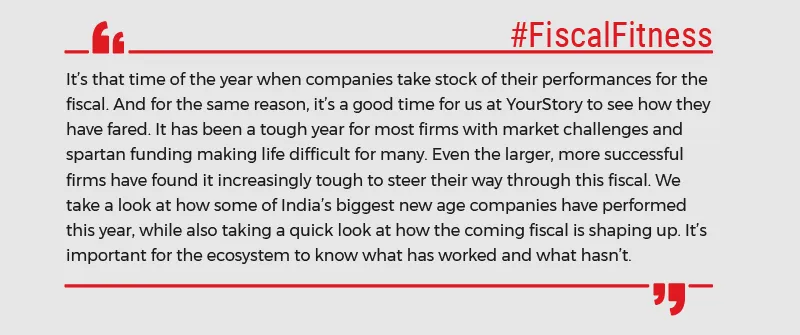From Flipkart understudy to standalone success story: How Myntra is set to grow 55 pc in FY 2018

Flagship ‘end of reason’ sale, in-house brands, customer-friendly policies, and strong data analytics may help fashion e-tailer Myntra close the year at $1.2 billion in GMV.
Amazon and Flipkart may be the biggies when it comes to ecommerce, but that’s no reason to ignore Myntra, a Flipkart subsidiary. An understudy of Flipkart for about four years now, the fashion shopping site has become a success story. Last year, it totted up revenue of Rs 2,000 crore according to ROC data; this year, it’s aiming higher.
The growth of this company can actually make the likes of Future Group and Aditya Birla, who are large brick and mortar retailers, look up and take notice of the way these digital retailers use data to target customers.
For FY 2018, Myntra says is seen clocking 55 percent growth overall, and its private labels are growing at 100 percent. The company's flagship “end of reason” sale has helped it see exponential growth in categories such as active-wear and fast fashion; the premium category and other accessories have contributed significantly to the growth of the organisation.

Ananth Narayanan, CEO of Myntra, says:
“We have witnessed extensive growth in certain categories and have leveraged our brand associations and private brands to augment growth. We foresaw demand in categories through strong data analytics and addressed those with new brands, designs, styles, and the latest trending products.”
He says the company's big sale days such as EORS (End of Reason Sale) and MFU (Myntra Fashion Upgrade) offered consumers the opportunity to shop with a reason, and also acquire new customers.
AI and omni-channel bets
Myntra’s tech platform Rapid allowed it to disrupt the way fashion is being experienced, and will be explored in the future. The platform enabled it to estimate demand and plan fashion, helping to cut costs and reduce discounts.
The company says Rapid, an AI platform, recognised patterns, colours, and consumer fits, and helped Myntra order garments that were popular.
The technology would crawl databases of Flipkart and Myntra to figure out attributes like types of sleeves and design patterns. One of their brands, Modarapido, was born out of data crunching. The organisation claims that AI has increased sales and has decreased the manufacturing process to less than 60 days.
“We looked at addressing one of the most important and perceived drawbacks of online fashion shopping, which is the lack of ‘touch and feel’ factor of products before undertaking a purchase. That’s why we embarked upon an omni-channel model that allows us to create multiple touch points with our consumers and offer them more channels for shopping,” Narayanan says.
Currently, Myntra’s in-house brand Roadster and its association with brands Mango and Esprit, whose physical stores are managed by Myntra, are good examples of an online retailer making an omni-channel bet.
The other important aspect of Myntra’s growth is the availability of the latest in global fashion. In addition to these, the e-tailer has in place policies such as 30-day return and “try and buy” (where a customer can choose up to three sizes and return ones that don’t fit them), which are beginning to attract a lot of offline and traditional shoppers.
This year, Myntra hopes to close the year at $1.2 billion in GMV. The company claims its contribution margin (margin after subtracting operational and manufacturing expenses) is positive, but it will continue to invest in structural improvements in the business.
Growing private labels
The company is built on private labels and expects to scale up that business. Roadster, for example, has grown approximately 80 percent over the last four years. Additionally, Myntra started the Brand Accelerator in the year 2017, and has on-boarded five brands on to the programme so far. This programme expects to create almost $1 billion dollars in sales by 2023.
Currently, Myntra has over 20 million monthly active users on the platform. The company claims that shoppers visit the site 12 times a month and shop about 5.8 times a year.
Myntra, like other ecommerce firms, sees growth from smaller towns. “Tier II markets did exceptionally well for us with a contribution of 55 percent to the overall revenue. This was primarily due to our efforts in tapping into consumer insights and addressing the consumer need gaps,” Narayanan says.
It’s also note-worthy that when they acquired Jabong, it had a negative growth rate, but this year an over 40 percent growth seems likely for Jabong.
The company is looking at opening a few physical stores this year for Mango, Espirit, their in-house brands, and multi-brand stores for personal care.
However, Ananth is also a fan of the physical retailing business.
“In our opinion, physical business is not going away any time soon; the brand’s omnipresence will matter. More people are expected to explore online and use both channels depending on availability of time and the type of product they are looking to buy,” he says.
Betting on the future
Myntra’s in-house research indicates that India has 450 million people who access the internet and that this is expected to grow by 62 percent to 729 million by 2020.
Myntra has placed big bets on the future. “Today we have approximately 60 million product purchasers. This number is expected to go to over 300 million customers by 2022. This presents new opportunities for brands to engage with their customers beyond brick and mortar,” Ananth says.
Access to the internet and penetration of smartphones also play a major role in the growth of online business, as Your Story stated in a recent report.
Finally, there is a burgeoning 361 million Gen Z population in India, which is growing up on the internet with little inhibition to technology. Adapting to online fashion shopping is anticipated to be much faster from this segment.
So Myntra seems set to pass the fiscal fitness test, and may soon be India’s favourite brand if its “phy-gital” bet succeeds.











